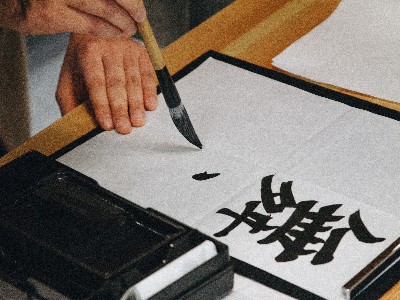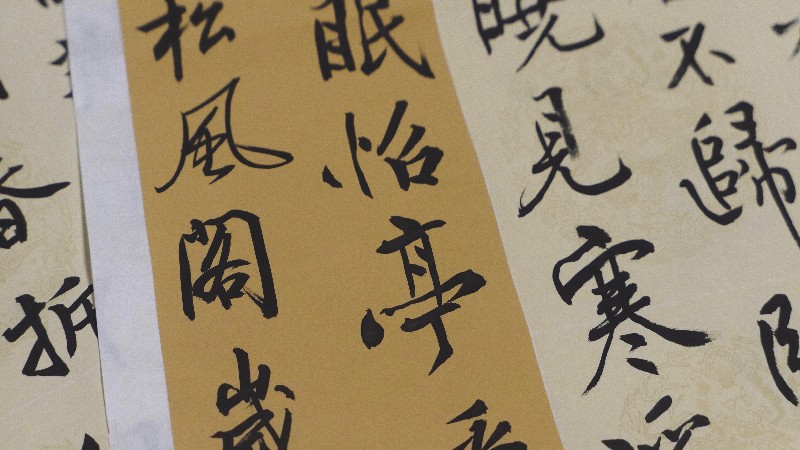Calligraphy is called ‘shodo’ in Japan, and it is an art form with a very long history. While calligraphy using the alphabet isn’t popular anymore in the West, in Japan it is still alive and kicking. How did Japanese calligraphy evolve? And what is the function of calligraphy in modern Japanese society?

History of Japanese Calligraphy
Japan didn’t have its own writing system until it was imported from China in the 6th century. With the import of the Chinese writing system came calligraphy. In the beginning, the writing style was very similar to the Chinese style. But soon after the invention of hiragana and katakana Japan started to develop its own style of calligraphy.
Early on in the Heian period, it was only members of the Imperial court, noblemen, and higher-up Buddhist clergymen who were taught how to read and write. Commoners only started to learn reading and writing from the Edo period, and it was still mostly the upper classes who went to school. Lower-classed individuals came together to pay a young teacher to teach their kids elementary reading and writing. And similar to the West, girls were much less likely to be educated than boys.
From the Meiji period, more and more people get an education as this was the start of public education in Japan. The Japanese education system was modeled after European systems at first. After WW2, American influences also became visible in the education system. But through it all, calligraphy has always been a basic subject.
Calligraphy in Japan Today
Every schoolchild spends a few hours per week practicing their calligraphy skills. They learn how to read and write from age 6, and this education continues all the way through to university. There are many kanji (Chinese characters) to study so it takes them much longer to learn how to write like an adult in Japan. It is said that you can tell someone’s level of education quite easily by seeing which kanji they know.
But it is not only the number of kanji that you can read and write that is important. The way you write them is almost equally important to many potential employers as well. In Japan, it is still believed by many that you can tell someone’s character by their handwriting. Handwritten cover letters and resumes are still par for the course in Japan, especially for those who want to get hired by a large and more traditional company. This means that not just learning how to write kanji, but also learning how to write them neatly is an important part of elementary education in Japan.
Besides being important for getting a job, calligraphy is also believed to instill a sense of discipline and teach etiquette. Moreover, it is believed that practicing calligraphy can make one feel more tranquil and peaceful.
Calligraphy as Art and Performance
Calligraphy is not only of professional use, though. For many Japanese, calligraphy is an artistic hobby. Just like many people love to draw or paint, in Japan, calligraphy can also be used as a way to express yourself. Poetry is also often written down beautifully, as are Buddhist sutra. Also, whenever there’s an important word shared with the country, such as the ‘word of the year‘ or a new era’s name, this is done by having someone make a large calligraphy ‘painting’.
A newer style of calligraphy is making it into performance art. Performers use a very large brush and paper and write down a kanji with flair. It almost looks like a dance, and sometimes they use music for the performance as well. Usually, performers are of high school age, and it is often done in a group.
Writing Technique
If you want to do calligraphy properly, you need to start with getting the right materials. That means that you will need to get a fude brush, sumi ink, and a suzuri inkwell. What you write on will of course also make a big difference. So for best results, you will need hanshi paper, a shitajiki felt pad, and a paperweight.
The way you hold your brush also matters. You can either hold it like a regular pencil, but for some extra stability, you can choose to also add your ring finger. With that method, you will use all your fingers except for the pinky. Then, it is good to know how many strokes are in the kanji that you’ve chosen, and what the correct stroke order is.
Furthermore, it is a good idea to go over making the strokes in your mind before you actually put your brush on the paper. You only get one chance to get it right per paper, so think before you start as otherwise, you will likely waste a lot of paper.
Workshops in Japan
Would you like to have an authentic calligraphy experience when you are in Japan? These days, many calligraphy teachers offer workshops to tourists who are interested in trying their hand at it. In Tokyo, you can for example book a class at Tokyo Calligraphy Class. In Kyoto, you can try a workshop at Calligraphy Kyoto.
If you are looking for a more intimate private experience at the home of one of our calligraphy specialist guides, you can contact us for more information.
Your Japan Tour
As seasoned Japan experts, we create perfect Japan package tours including destinations related to calligraphy and other Japanese culture. Check out our group tours and private tours, or contact us to start planning your unforgettable holiday to this fascinating country full of once-in-a-lifetime experiences, culture, history, nature, and delicious food!

